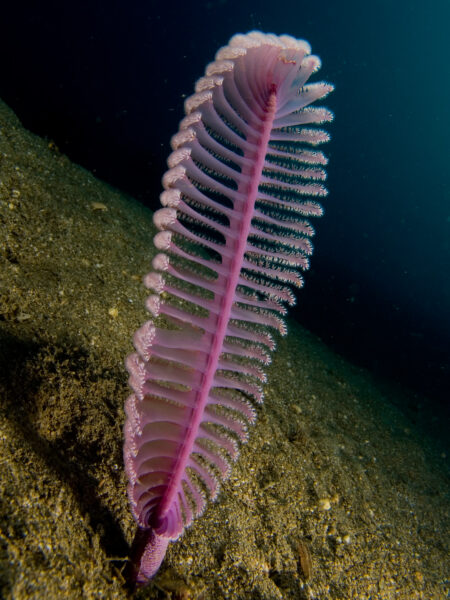Scientific Name: Pennatulacea
The Sea Pen, a soft coral belonging to the order Pennatulacea, is an intriguing marine organism found in oceans all over the world.
Physical Traits: Unique Structure and Bioluminescence
Unique Feather-like Structure
Sea Pens are colonial animals made up of multiple polyps. Their name originates from their resemblance to antique quill pens. Each Sea Pen consists of a central stalk, called the primary polyp or axis, with secondary polyps branching out like feathers. These secondary polyps perform various functions, such as feeding, reproduction, and respiration.
Bioluminescence: A Light in the Deep
Sea Pens possess the remarkable ability to produce light through bioluminescence. When disturbed, they emit a bright green or blue glow, potentially to deter predators or attract prey. This ability is particularly useful in the dark depths of the ocean where they dwell.
Life Span: Up to 100 Years
Sea Pens are known for their longevity, with some species living for up to 100 years. However, their exact life span can vary depending on the species, habitat, and environmental conditions.
Habitat: Ocean Floors Worldwide
Sea Pens are found in oceans across the globe, from tropical to cold-water environments. They inhabit soft ocean bottoms, such as sand or mud, at depths ranging from 10 to 6,100 meters. They anchor themselves to the substrate using their primary polyp, which acts as a root-like structure.
Diet: Filter Feeders
Sea Pens are filter feeders, primarily consuming plankton and other small particles suspended in the water. The feeding polyps on their branches capture food using their tentacles, which are covered in stinging cells called nematocysts.
Reproduction: Both Sexual and Asexual
Sexual Reproduction
Sea Pens reproduce sexually by releasing eggs and sperm into the surrounding water. Fertilized eggs develop into free-swimming larvae that eventually settle onto the ocean floor, where they metamorphose into a new primary polyp and begin growing secondary polyps.
Asexual Reproduction
Some Sea Pen species also reproduce asexually through a process called budding. In this method, new polyps form from fragments of the primary polyp or from the secondary polyps, eventually developing into a new colony.
Conservation Status: Data Deficient
Many Sea Pen species are currently listed as “Data Deficient” on the IUCN Red List of Threatened Species, meaning there is insufficient information to determine their conservation status. However, human activities such as deep-sea trawling, pollution, and climate change may pose threats to their habitats and populations.
Interesting Facts: Ancient Organisms and Medicinal Potential
Ancient Organisms
Fossil records reveal that Sea Pens have existed for over 500 million years, making them some of the oldest marine invertebrates on Earth.
Medicinal Potential
Recent research has shown that Sea Pens possess bioactive compounds with potential medicinal applications, such as anti-inflammatory, analgesic, and anticancer properties. Further studies are needed to fully explore these compounds and their possible uses in medicine.


